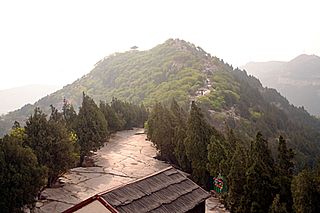 W
WHua Hill (Shandong) is a solitary cone-shaped hill in the lower Yellow River valley, located at the northeastern edge of the city of Jinan, Shandong Province, China. The hill is known for its cultural and historical significance as well as for its natural environment. It has been an inspiration for Chinese artists for many centuries and was the site of the Battle of An, a major battle fought during the Spring and Autumn period.
 W
WQue Hill is a small elongated hill located on the western shore of the Yellow River in the City of Jinan, Shandong Province, China. It is one of the solitary "Nine Hills" in the Yellow River valley within and to the north of Jinan City. Together with Hua Hill, which is today located on the opposite side of the Yellow River, Que Hill is depicted in a renowned painting by the Yuan-Dynasty era painter and calligrapher Zhao Mengfu entitled "Autumn Colors at Que and Hua Hills". The hill is positioned close to the northern end of the Luokou Yellow River Railway Bridge which was placed there because the hill stabilizes the course of the Yellow River. In November 1937, Japanese troops attacked the northern shore of the Yellow River and killed about 50 villagers who lived around Que Hill, the event became known as the Que Hill Tragedy.
 W
WThe Shandong Peninsula or Jiaodong Peninsula is a peninsula in Shandong in eastern China, between the Bohai Sea to the north and the Yellow Sea to the south. The name refers to the east and Jiaozhou.
 W
WThe Thousand Buddha Mountain is a hill located about 2.5 kilometers southeast of the city of Jinan, the capital of Shandong Province, China. It covers 1.518 square kilometers and has a peak of 285 meters above sea level. It is renowned for its numerous Buddha images which have been carved out of the hill's rock faces or free-standing structures erect since the times of the Sui Dynasty (581-618) and its Xingguochan Temple. It is considered as one of the "Three Greatest Attractions in Jinan" together with Baotu Spring and Daming Lake. It is also one of the 4A-rated Tourist attractions in China. Thousand Buddha Mountain is opened up as a public park in 1959, rated as AAAA-rated Tourist Attractions of China in 2005, and rated as National Park of China in March 2017.
 W
WThe Thousand-Buddha Cliff is a historical site of mostly Tang Dynasty rock carvings in central Shandong Province, China. Along a cliff face of 63 meters length, over 210 statues and 43 inscriptions have been reported. Most of the statues were carved during 618–684.
 W
WThe Yiyuan Rong Cave Group is a cluster of Ordovician limestone caves in the area under the administration of the city of Zibo, Shandong Province, China. Rong Cave proper is the namesake of the cave group. It is located about 13 kilometres (8.1 mi) to the north of the town of Tumen. The cave group contains more than 40 caves in total and is the largest cluster of limestone caves in China north of the Yangtze River. It covers an area of approximately 10 square kilometers. Other major caves in the group are Thousand-Men Cave , Resting Cave, Stone-Dragon Cave, Xuanyun Cave, Nine-Skies Cave, Coral Cave, Lingzhi Cave, Shenxian Cave, and Xiaya Cave. The Thousand-Men Cave was used as an arsenal by the Eighth Route Army from September 1938 to March 1939. Some of the major caves in the group have been made accessible to tourists as they are popular attractions.
 W
WZhongyuan, Chungyuan, or the Central Plain, also known as Zhongtu, Chungtu or Zhongzhou, Chungchou, is the area on the lower reaches of the Yellow River which formed the cradle of Chinese civilization. It forms part of the North China Plain.